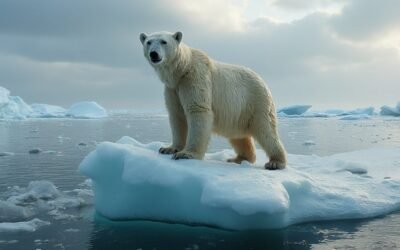Beluga whales exhibit unique cold water adaptations to thrive in Arctic environments. Their thick blubber, which can make up over 40% of their body weight, insulates against extreme temperatures and stores energy. The lack of a dorsal fin and an elongated dorsal ridge reduces heat loss and aids in swimming under ice. Belugas also possess a highly developed echolocation system for exploring dark, icy waters. Additionally, their circulatory system employs countercurrent heat exchange to conserve body heat efficiently. These adaptations, combined with social behaviors and vocal communication, secure their survival in harsh conditions. Explore further to uncover more fascinating details.
Main Points
- Beluga whales have a thick blubber layer for insulation and energy storage in frigid waters.
- Their streamlined body and lack of a dorsal fin minimize heat loss and improve swimming efficiency.
- The countercurrent heat exchange system conserves body heat by warming cooler venous blood with arterial blood.
- Enhanced diving adaptations, like bradycardia and high myoglobin, optimize oxygen use in cold environments.
- Their echolocation abilities enable them to navigate and hunt effectively in dark, icy waters.
Physical Characteristics
Beluga whales possess several distinct physical characteristics that enable them to prosper in the frigid Arctic waters. One of the most notable features is their thick blubber layer, which not only provides insulation against the cold but also serves as an energy reserve. This blubber can account for over 40% of their body weight. Another key adaptation is their white color, which camouflages them against the sea ice, offering protection from predators. Unlike many other cetaceans, belugas lack a dorsal fin; instead, they have an elongated dorsal ridge, which is particularly useful for steering and breaking through thin ice.
The beluga's streamlined body shape is complemented by small tail flukes and pectoral flippers, enhancing their swimming efficiency in the dense, icy waters of the Arctic environments. Additionally, belugas possess a prominent structure known as the melon on their head. This melon is vital for echolocation, which aids in prey detection and communication in the often murky and dark Arctic waters. These physical characteristics collectively guarantee that beluga whales are uniquely adapted to their harsh, cold habitats, enabling them to survive and thrive where few other species can.
Blubber and Insulation
One of the most important adaptations for beluga whales in their Arctic environment is their thick layer of blubber, which provides both insulation and energy storage. Blubber comprises over 40% of a beluga whale's body weight, playing a crucial role in insulating these marine mammals from the frigid Arctic waters. This dense layer of fat is essential for maintaining their body temperature and ensuring survival in their icy habitat.
The blubber not only serves as insulation but also helps streamline the beluga's body for more efficient swimming. Additionally, this layer acts as an energy store, providing necessary reserves during periods when food is scarce. This is vital for beluga whales, given the harsh and variable conditions of their environment.
Furthermore, the beluga whale's circulatory system plays a significant role in its cold water adaptations. The system can adjust to conserve or dissipate body heat as needed, which is crucial for maintaining core body temperature. These unique adaptations, including their substantial blubber layer, allow beluga whales to thrive in some of the coldest waters on Earth, ensuring their survival and continued presence in the Arctic waters.
Echolocation Abilities
Echolocation abilities are a pivotal adaptation that enables beluga whales to explore and thrive in their dark, icy habitats. This specialized echolocation system allows belugas to emit sound waves that bounce off objects and return to them, providing a detailed sonic map of their surroundings. This capability is essential for exploring through the often treacherous ice-covered waters of the Arctic and sub-Arctic regions.
Beluga whales utilize echolocation to locate prey, which is crucial for their survival in these harsh environments. The dark, icy waters can obscure vision, making it difficult to find food through sight alone. By using echolocation, belugas can detect the presence of fish and other prey even when visibility is low. This sophisticated system also facilitates communication among individuals, allowing them to relay information and coordinate movements, which is particularly important in the dense ice fields where they live.
Moreover, the ability to explore effectively through ice-covered areas ensures that belugas can migrate, find open breathing holes, and avoid predators. In summary, their exceptional echolocation abilities are essential for the survival and success of beluga whales in their challenging Arctic and sub-Arctic habitats.
Diving Adaptations
Diving adaptations in beluga whales are crucial for their survival in the profound, cold waters of the Arctic and sub-Arctic regions. These remarkable creatures possess specialized diving adaptations that enable them to thrive in such extreme environments. One of their key adaptations is the ability to collapse their lungs, a mechanism that prevents decompression sickness, commonly known as 'the bends,' during profound dives.
Beluga whales also exhibit bradycardia, a physiological adaptation where their heart rate slows down significantly. This process conserves oxygen and redirects blood flow to essential organs and muscles, ensuring their functionality during prolonged dives. Additionally, belugas have evolved muscle adaptations that include high levels of myoglobin, a protein that stores oxygen in muscle tissues, facilitating sustained underwater activity.
The whales' blood is rich in hemoglobin, another oxygen-storage molecule, which enhances their ability to undertake extended dives. This is complemented by efficient CO2 clearance from their blood, optimizing oxygen availability for muscle function. These combined physiological and muscle adaptations enable beluga whales to undertake specialized diving practices, allowing them to forage for food and navigate their frigid aquatic habitats effectively.
Thermoregulation Techniques
Beluga whales employ several thermoregulation techniques to thrive in frigid Arctic waters. A thick layer of blubber, comprising over 40% of their body weight, serves as a primary insulator. Additionally, their circulatory system, including the countercurrent heat exchange mechanism, is adept at conserving body heat and adjusting to environmental conditions.
Thick Blubber Insulation
With a blubber layer comprising over 40% of their body weight, beluga whales possess an essential adaptation for effective insulation in frigid waters. This thick blubber serves as a formidable barrier against the cold, ensuring that these marine mammals maintain a stable internal body temperature despite the icy conditions of their Arctic and sub-Arctic habitats. The blubber's insulating properties are pivotal for beluga whales, whose survival depends on minimizing heat loss in such extreme environments.
In addition to providing insulation, the thick blubber also functions as a significant energy storage reserve. This stored energy can be utilized during periods when food is scarce, further enhancing the whales' ability to endure and thrive in cold water conditions. The circulatory system of beluga whales plays a complementary role in their cold water adaptation. By adjusting blood flow, their circulatory system can either conserve or dissipate body heat as needed, supporting efficient thermoregulation.
These physiological adaptations, including the thick blubber and circulatory adjustments, enable beluga whales to manage heat exchange effectively. This multifaceted approach to thermoregulation allows them to inhabit the extreme cold of Arctic and sub-Arctic waters, showcasing the remarkable evolutionary strategies of these marine mammals.
Countercurrent Heat Exchange
In addition to their thick blubber insulation, beluga whales employ a sophisticated thermoregulation technique known as countercurrent heat exchange to further conserve body heat in frigid waters. This physiological adaptation involves the close proximity of arterial blood, which is warm, and venous blood, which is cooler. As warm arterial blood flows into the extremities such as flippers and flukes, it transfers heat to the returning venous blood. This process minimizes heat loss and conserves body heat, necessary for survival in cold water environments.
The countercurrent heat exchange system allows belugas to maintain a stable body temperature even in harsh Arctic conditions. By regulating heat transfer between blood vessels, belugas optimize their swimming efficiency, ensuring that their extremities do not become too cold and reduce their functional capabilities. This adaptation is essential for belugas as they navigate icy waters, enabling them to thrive where temperatures can plummet drastically.
Circulatory System Adaptations
The circulatory system of beluga whales exhibits remarkable adaptations that enable efficient thermoregulation in the harsh Arctic environment. One of the most significant adaptations is the countercurrent heat exchange mechanism in their arteries and veins, which allows belugas to maintain a stable body temperature in cold waters. This system facilitates the transfer of heat between blood flowing to and from extremities, conserving warmth and reducing heat loss.
Furthermore, the circulatory system of belugas is adept at regulating blood flow to crucial organs and muscles during dives, ensuring that these areas receive sufficient warmth and oxygen. This precise control over blood distribution is pivotal for their survival in frigid waters.
Additionally, belugas possess a thick layer of blubber that serves multiple purposes: it provides insulation, aids in thermoregulation, and acts as an energy storage medium. This blubber layer is indispensable for maintaining body heat and conserving energy in the cold Arctic environment.
Behavioral Traits
Beluga whales exhibit sophisticated behavioral traits essential for their survival in Arctic environments. These include forming cohesive social groups that enhance foraging efficiency and predator defense, along with utilizing an extensive range of vocalizations for navigation and maintaining social bonds. Additionally, their cooperative hunting strategies and remarkable curiosity enable them to adapt effectively to the dynamic and icy habitat.
Social Interaction Patterns
Social interaction patterns among beluga whales play a pivotal role in their survival within the harsh Arctic and sub-Arctic environments. As highly social animals, belugas are often found in groups of belugas, or pods, typically consisting of 5 to 25 individuals. In certain circumstances, these pods can amalgamate into larger groups known as mega-pods, sometimes containing up to a thousand members. These social structures are essential for protection against predators and efficient resource sharing.
Belugas exhibit a range of cooperative behaviors that underscore their social intelligence and adaptability. Their curiosity towards humans and ability to be trained are further indicators of their cognitive capabilities and flexible nature. Social bonds among belugas are strengthened through various interactions, such as engaging in group activities like moulting and scratching. These behaviors not only foster unity but also play a critical role in their overall well-being.
Key aspects of beluga whale social interaction include:
- Living in small pods and forming mega-pods
- Cooperative behaviors for mutual benefit
- High levels of intelligence and curiosity
- Strong social bonds manifested through group activities
- Adaptability to changing environments through social learning
Vocal Communication Methods
Often referred to as the 'canaries of the sea,' beluga whales display an extraordinary range of vocalizations that play an important role in their communication and social interactions. Their vocal communication methods involve diverse sounds, including whistles, clicks, chirps, groans, trills, buzzes, and roars. This extensive vocal repertoire is essential for their social bonding, navigation, and survival in the cold Arctic waters.
Belugas are enthusiastic vocal communicators, showcasing advanced vocal capabilities that allow them to produce a wide array of vocalizations. These sounds are not just random noises but are used strategically to facilitate various social interactions, from maintaining group cohesion to coordinating hunting efforts. Remarkably, belugas can also imitate sounds, including human speech, highlighting their sophisticated communication methods.
Their ability to produce such a diverse range of sounds is crucial to their adaptation to the Arctic environment, where visual cues can be limited due to ice cover and murky waters. Therefore, their vocal communication methods serve as a vital tool for interaction and survival. Essentially, the beluga whale's extensive vocal repertoire is a testament to its evolutionary adaptation to the unique challenges of its habitat.
Do Beluga Whales’ Unique Cold Water Adaptations Help Them Perform Their Quirky Survival Tricks?
Beluga whales have developed fascinating adaptations to survive in icy waters, including their thick blubber and flexible necks. These features enable them to navigate and hunt effectively while avoiding predators. The beluga whales’ cold water tricks, like using echolocation to find holes in sea ice, showcase their unique survival abilities in extreme environments.
Conclusion
Beluga whales possess a range of unique adaptations that facilitate survival in cold water environments. These include specialized physical characteristics, substantial blubber for insulation, advanced echolocation abilities, and diving adaptations. Additionally, effective thermoregulation techniques and specific behavioral traits further enhance their ability to thrive in frigid conditions. Collectively, these adaptations guarantee that beluga whales are well-equipped to navigate and endure the challenges presented by their icy habitats.


